Witnesses Wait
Air Date: Week of February 22, 2008
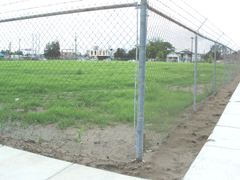
Site of the former Thompson Hayward Chemical Co. (Photo: Ingrid Lobet)
A Living On Earth investigation has found neighbors of a plant that once produced some of the most dangerous herbicides and insecticides known to man may be being left unprotected. The State of Louisiana has cleaned up the site itself, but some neighbors say their homes should be cleaned up or purchased, and some toxicologists agree.
Transcript
CURWOOD: And here’s another tale of who gets to live on polluted soil. It’s the story of three acres of land and the community surrounding it. It’s a part of New Orleans, known as Gert Town. About 70 years ago, the Thompson Hayward Chemical Company bought the plot and set up a small operation mixing pesticides, often outdoors.
Cane farmers bought the insecticides and by the 1960's, plantations, exterminators, and even the federal government turned to Thompson Hayward for chemicals such as DDT, Aldrin, and the one locals called "leaf drop" - Agent Orange. But in the late 1980’s when Louisiana found the plant was dumping solvents into sewers, state authorities shut it down. And ever since, homeowners in Gert Town have hoped for full cleanup. But as Living on Earth's Ingrid Lobet reports, they're still waiting.
[TRAFFIC SOUNDS]
LOBET: Last Fall, Louisiana reached a milestone. It hauled away the last poisonous soil from the old Thompson Hayward chemical site. Now cars on Earhart Boulevard speed past a stretch of fresh green grass.
[TRAFFIC SOUNDS FADE]
MALLET: It's gone very well, in fact it's one of the success stories of DEQ and this administration.
LOBET: Rodney Mallet is spokesman for Louisiana Department of Environmental Quality. Hurricane Katrina slowed down his department's cleanup plans, but didn't stop them.
MALLET: Something that has been a problem site and a concern for residents in New Orleans has been taken care of. That area right there is cleaned up to commercial use standards and it hopefully will be put back into commerce shortly.
LOBET: But the pesticides drifted beyond the plant's perimeter, to the yards and porches of the modest homes surrounding it. Johnnie and Dorothy Leonard watched what went on there for 45 years.
J. LEONARD: From here, we seen everything they doin'.
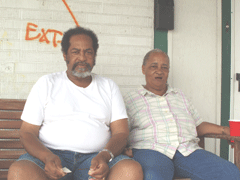
Johnnie and Dorothy Leonard raised six children across from the Thompson Hayward chemical plant in New Orleans. (Photo: Ingrid Lobet)
LOBET: Sitting on the couch by the air conditioner, the Leonards vividly recall how forklift drivers held bags of dry pesticide high over huge, outdoor mixing kettles.
J. LEONARD: Most of it was dry and it'd blow when they was mixing it. Fifty pound bags or hundred pound bags, and they’d cut it, just pour it out and quite naturally when the wind is blowing it, takin’ it, you know. That’s when it get bad, that's when you couldn’t set on your porch, you couldn’t be outside you know, cause then it’d strangle you. It almost take your breath.
LOBET: The Leonards raised six children in this home. Johnnie Leonard worked at a Borden's dairy for twenty years, and then as an Amtrak porter for twenty more. Dorothy remembers with a smile when they owned a restaurant that sold buckets of sausage on weekends. But the heavy dust from the plant was always there, coating cars, walls and window sills.
D. LEONARD: That chemical smelled so bad… if you had your windows let up, you could smell the chemicals.
J. LEONARD: When they was mixing that stuff you wouldn't dare put a window fan on because you know what that would do, just blow all that stuff inside. You just have to cage yourself up when that was going on. Cause you couldn’t sit outside and you couldn’t put your fan on. Yeah. That went on for years, years.

Site of the former Thompson Hayward Chemical Co. (Photo: Ingrid Lobet)
LOBET: One of the children, Robbie, now a 40-year-old drywaller, struggled with recurrent rashes and asthma.
R. LEONARD: Cause we would be at the emergency room, they would clear it up! But soon as I get round here, that's when it would flare back up. And we had to go back. It was terrible, that's how it went for years. My whole childhood life, yes.
LOBET: Nearly all the residents of Gert Town are African-American. No one can remember a survey of people’s health here, but over the years the pollution did attract the attention of some advocates.
SUBRA: My name is Wilma Subra. I’m a chemist and I provide technical assistance to community groups dealing with environmental issues.
LOBET: Wilma Subra created her own analytical chemistry lab in rural southern Louisiana in 1981. Her work is controversial. Not long ago Subra's husband watched as a vehicle cruised back and forth, then someone took a shot at the house. Subra pointed out the hollow in the brick beside front door.
SUBRA: So, I got a security person to come in. He said put bullet-proof glass on all the windows, move all the computer stuff so you work in the back half, don’t work here after dark…
LOBET: When Hurricane Katrina struck, Subra had already taken samples outside the Thompson Hayward site. Worried that the floodwaters would spread the contamination, she crossed police lines to get back to New Orleans.
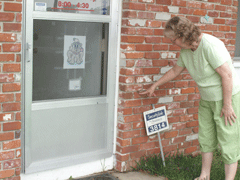
Chemist Wilma Subra points to the bullet hole by her front door in rural Louisiana. Her work on behalf of community groups is often controversial. (Photo: Ingrid Lobet)
SUBRA: I was out doing samples of that sediment sludge, then EPA would come back and do additional sampling where I found the hotspots. If I hadn’t been out there doing that kind of work, and if I wouldn't have had that data, and then given that data to the community and then gone to the Agency and said look what I found, no one would have ever sampled in that area.
LOBET: The EPA did follow up, testing dirt at nine sites in the neighborhood, including one a few steps from the Leonards' home. Subra photocopies the results she keeps in a file cabinet.
[Sound of paper rustling]
SUBRA: Now as you see, there is offsite contamination based on EPA's data and it extends over a block in each direction from the site. Chlordane exceeded the limit by 2.4 times. Now Chlordane has been banned from use in the United States. It’s very persistent, very long lasting. The DDT chemicals and their metabolites were 3.8 times over the acceptable limit at this one location. And then Dieldrin was almost 40 times the limit.
The issue here is very toxic, very persistent pesticides, very readily available for the community to come into contact with.
LOBET: Living On Earth obtained the electronic records for twenty-four thousand post-Katrina soil samples taken by EPA in Louisiana. Of the thousands of tests, the sample taken closest to the Leonards' front porch showed the highest concentrations of several dangerous pesticides: the termite killer Chlordane, DDT, Dieldrin, Endrin and Endosulfan.
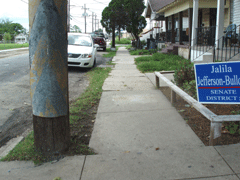
Site of a soil sample that tested high for several banned insect killers on Colapissa Street. On the left is the old Thompson Hayward Chemical site. (Photo: Ingrid Lobet)
The EPA agrees the test results are over the threshold of concern. But it doesn’t believe the neighborhood needs a cleanup. Jon Rauscher, the EPA toxicologist who assessed the risk, says the levels in Gert Town would cause fewer than one extra cancer in ten thousand people.
RAUSCHER: The pathway we looked at was a person living near those soils, and routinely contacting those soils, including if a child were to contact the soils and do so on a routine basis. We look at a child inadvertently ingesting soil, or eating soil. Children have fairly high soil ingestion rates from handling toys and putting their hands in their mouth.
At this point, EPA does not have any evidence that would lead us to do any additional work.
LOBET: That is, not unless the State of Louisiana requested it. But Rodney Mallet of the Louisiana Department of Environmental Quality says the state is not going to ask.
MALLET: People say ‘There's pesticides there.’ Well there's pesticides there. But there's pesticides everywhere, and if you go to the up-end neighborhoods, higher-end neighborhoods, you're going to find a lot more pesticides, because they’re the ones who have the disposable incomes to take care of their yards, and they're big into taking care of the yards.
LOBET: But common lawn treatments like Roundup aren’t nearly as dangerous as the compounds found in Gert Town such as DDT and Chlordane. These insect killers build up in the body, and have been banned for decades. Whatever Mallet says, records show they’re not widespread in New Orleans. DDT wasn't found in most of the soils where experts looked for it after Katrina. In other words, Gert Town stands out. Mallet insists the soils pose no risk.
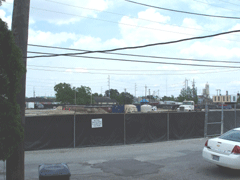
Site of the Thompson Hayward Chemical Co., under cleanup late 2007. The same company left several other contaminated sites across the country. (Photo: Ingrid Lobet)
MALLET: The pesticides that were found were typical background levels, that if it was going to be health risk to someone, you would have to eat a liter of soil a day for two hundred-plus days for it to become a problem.
LOBET: Yet in fact eating that liter of soil near the Leonard's home would put someone hundreds of times over the EPA level of concern for Chlordane alone.
Living on Earth showed the Gert Town soil tests results to three California toxicologists. Michael Anderson assesses eco-toxicological risk for the State. He pointed out other ways people could be exposed besides eating soil.
ANDERSON: If you add into that homegrown produce, if a person was to have a backyard garden, or if you add in breast milk for an infant, the risks rise dramatically. The risks now go up almost two orders of magnitude.
LOBET: Which means if the site were in California, the government response would likely be different.
ANDERSON: If this was the information that we were given and we were confident in the data, we would recommend a remedial action.
LOBET: You would recommend a remedial action.
ANDERSON: Oh yeah.
LOBET: The other toxicologists agreed. Another toxicologist was more blunt. Professor Marcus Iszard used to teach in New Orleans, and once gathered samples in Gert Town. Now he teaches toxicology at the University of Missouri Kansas City.
ISZARD: There should be a large outcry. This type of chemical exposure is unacceptable, period. This could never happen in anybody else's neighborhood. This could not happen on the north shore of the New Orleans residential area. This would never happen. We’re talking about a neighborhood where it seems that those who are in power have just abandoned.
LOBET: At home in her living room, Dorothy Leonard says over the years men have come several times and said her neighborhood would be cleaned up, or that residents would be bought out. But nothing's come of it.
D. LEONARD: And they shoulda been did that. They knew that place was making the people sick around here. We couldn’t even sit on our porch. With the doors closed we could smell it in our house. We could be driving in our car, our windows could be completely up, we could still smell it in our car. They didn’t care.
LOBET: Whether they care or not, what’s in the soil will stay there. Experts say the pesticides don’t dissolve in water, and they’re bound to the soil. For Living on Earth- I’m Ingrid Lobet.
Links
Find out more about post-Katrina EPA soil sampling
Make connections to support Gert Town
State of Louisiana documents on Thompson Hayward site cleanup
Living on Earth wants to hear from you!
Living on Earth
62 Calef Highway, Suite 212
Lee, NH 03861
Telephone: 617-287-4121
E-mail: comments@loe.org
Newsletter [Click here]
Donate to Living on Earth!
Living on Earth is an independent media program and relies entirely on contributions from listeners and institutions supporting public service. Please donate now to preserve an independent environmental voice.
NewsletterLiving on Earth offers a weekly delivery of the show's rundown to your mailbox. Sign up for our newsletter today!
 Sailors For The Sea: Be the change you want to sea.
Sailors For The Sea: Be the change you want to sea.
 The Grantham Foundation for the Protection of the Environment: Committed to protecting and improving the health of the global environment.
The Grantham Foundation for the Protection of the Environment: Committed to protecting and improving the health of the global environment.
 Contribute to Living on Earth and receive, as our gift to you, an archival print of one of Mark Seth Lender's extraordinary wildlife photographs. Follow the link to see Mark's current collection of photographs.
Contribute to Living on Earth and receive, as our gift to you, an archival print of one of Mark Seth Lender's extraordinary wildlife photographs. Follow the link to see Mark's current collection of photographs.
 Buy a signed copy of Mark Seth Lender's book Smeagull the Seagull & support Living on Earth
Buy a signed copy of Mark Seth Lender's book Smeagull the Seagull & support Living on Earth

